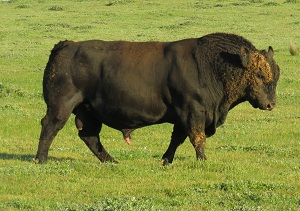Xmas 2020
| The year started hazey With paddocks a blaze Coronavirus hit And we said oh shit! Finally it started to rain a bit The season was a cracker With balers and headers going flat knacker Christmas is here And boy what a year Now its time to spread some cheer And get on the beers! Merry Christmas Everyone Davo |
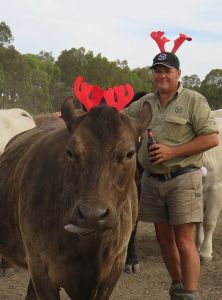 |
31/12/20
Vale Neill Burke
It was with great sadness that we learned the news of Neill's passing on 27th December. Davo spent many happy hours with Neill, texting and talking about breeding and genetics, bouncing ideas backwards and forwards. It was exciting and a privilege to be able to work with Neill to introduce new genetics to New Zealand: his passion, energy and innovation were inspiring. We have fond memories of our trip to NZ in 2015 when we were blown away by Neill and Jane's generosity, and their trip to Australia in May last year. Neill will be sadly missed - we look forwards to keeping in contact with Jane and the family, and keeping Neill's memory alive.
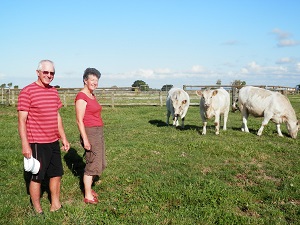 |
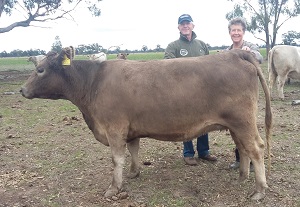 |
4/11/20
Well October was a busy month with a second load of silage made and joining. With green feed well into November there was extra work tackling weeds and trying to maintain pasture quality.
Bale-up hay feeder
I have been looking at Bale-up feeers for a few years and have been keen to get one. The bulls are always breaking my lighter hay rings and I was looking for something more substantial. The Bale-Up feeder are designed to minimise wastage. Up to 30% of hay can be wasted feeding out in a hay ring and we've had some lovely short hay in recent seasons which falls out of the hay rings really easily - sometimes we feel like we are losing that 30% as soon as we open the bale! I have been very impressed with my new Bale-Up feeder and the way the bale sits in the middle and the silage slides down the sloping floor towards the cattle. They seem to push on the feeder less and the design stops them from pulling silage out of the feeder. It has been remarkable to see how little feed is falling out of the feeder and getting fouled on the ground. In the photo on the left you can see the wastage where the previous hay ring stood, on the left, and no wastage round the Bale Up feeder on the right.
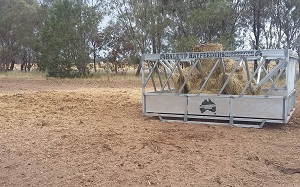 |
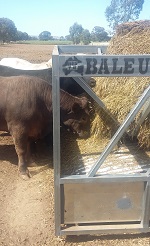 |
Green feed in November
After two failed Springs it's very pleasing to get some Spring rain and see how much feed we can actually grow. The seasona has been fantastic. It hasn't really got too wet, and the conditions have been mild which has been very good for pasture growth and silage yields. It's been a challening year for those trying to make hay and we chose not to this year because of the frequent rain-bearing weather fronts which make curing hay difficult. Even in the first week of November, the paddocks are still very green and feed is actively growing.
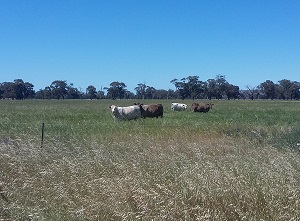
Joining
We have AId the majority of the heifers and a select group of cows. So far I have been rapt with the calves from Jupiter, Intensity and Peregrine so we feel the bulls we've got in the paddock at the moment are equivalent or better than the ones we have in the AI tank. Quixote was also used lightly - Maisie was treated to this view of her cow Katrina M3 being served by Quixote as she got off the school bus one day. I am using some The Glen Keystone, Te Mania Emperor and Carlinga Mordred semen again to try and breed our next bull.
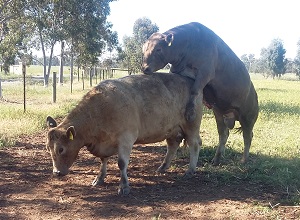 |
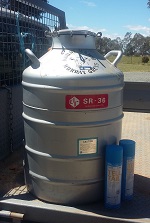 |
Second load of silage
We've cut a second lot of silage and have ended up with just under 500 rolls which is more than we've cut in the last three years put together. The quality of the silage is very high as it was cut early and the paddocks have re-grown really well so there will be a fair bit of grazing on those once we get round to them.
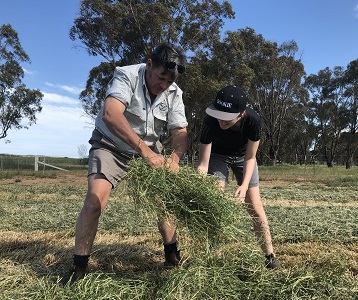
Calving wrap-up
Calving went very smoothly. The cows were very overweight after a good autumn and winter so calf weights were almost 2 kg heavier than last year's average but there was nothing unreasonable and only one cow needed assistance, a heifer. We had all cows calved by 9 weeks but would like to tighten up our calving pattern and have more cows calved in the first three weeks. We had 20 bulls and 19 heifers, so even Stevens, and a good mix of new genetics coming in. We've got quite a few Intensity bull calves and some outstanding Keystone bull calves (I'll be putting a list on the Bulls for Sale page very soon). I've got a full sister to Quantum which I am pleased about and a good spread of heifers from a range of bulls, so I'm really happy.
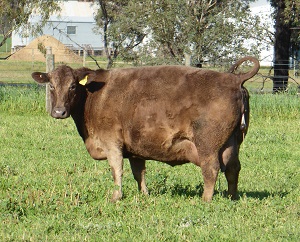
27/09/20
Quantum off to Tassie
We were pleased to wave Quantum off on his journey to Tasmania. He passed scanning, assessment and breeding soundness exam with flying colours and we hope he does very well in his new home.
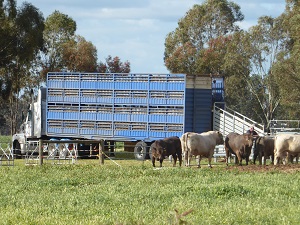
Bull breeding soundness exams, scanning and assessment
Every year we get our bulls and heifers independently assessed at scanning by Liam Cardile of Beef Xcel. We value his opinion and it's good to get an outside view of our stock. It is disapointing when we have to cull otherwise fantastic animals for poor conformation but we know that this puts rigour into our breeding program and gives us confidence in being able to guarantee bulls to our clients.
Then all our sale bulls receive a veterinary bull breeding soundness exam, courtey of GV Vets, before they are sold, again giving us the confidence to guarantee our bulls. The breeding soundness exam includes a crush-side semen assessment under the microscope and then samples are sent away for lab morphology. We will also do a pestivirus test as an indicator of our herd exposure and the individual animal's susceptibility.
Jupiter is a prime example of the value of this sort of data collection. His figures have gone up a heap - he's gone from being a very good bull to elite because we have submitted scanning data from his daughters. Basically, if you don't measure you don't know. I bought Jupiter as calf based on his pedigree that told me he should be able to to lift IMF in our herd. Because I bought him as a calf, he wasn't able to be compared with his any other comparable youngstock and only had a mid-parent mean when I bought him. And because he went from drought at Rogialyn to drought at Mount Major, he didn't have the opportunity to express his genetics in his early growth. But now that we have entered scan data from 20 daughters and sons there is much greater reliability in his figures. Pedigree tells you what a bull should be, performance tells you what he is (under the prevailing conditions) but progeny test and breeding values tell you what he passes onto his offpsring. The data could have told us that he is not as good as predicted, which we would still want to know, but we are thrilled that his IMF has lifted him to an elite level.
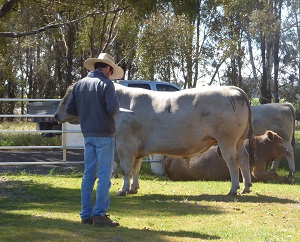 |
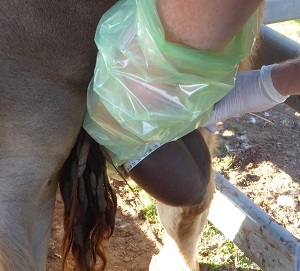 |
10/09/20
Silage
With the excellent season we're having, we have a big bulk of feed in front of us and surplus to the cows' requirements at the moment. I had sowed a paddock of early oats, ryegrass and clover that was intended for grazing but we didn't get round there. With the outlook of a wet spring, we took the opportunity to try and make some early silage. Part of the challenge this year was having paddocks dry enough to be trafficable (such a flip from the last couple of years where we had no grazing at all were feeding out at this time of year!!!). The paddock looked like it could have done with a bit more nitrogen and the wetter areas looked like growth had been affected a bit so we guessed that it would yield about 4-5 t DM/Ha. But when it was cut, we were surprised at how big the winrows were and when we started baling and got through the fourth winrow, we were getting more and more bales as we progressed into the heavier yielding areas of the paddock and realised our guess-timates were well and truly out the window. With the speed and efficiency of our contractor's new machines (big shout out to Luke Felmingham, LKF Contracting), the trusty David Brown tractor was not quite able to keep up and I had to call my neighbour to lend a hand for a few hours to keep in front of the wrapper. We worked into the night and the final result was a substantial 6 tDM/Ha - good work for an early cut. Touch wood, we managed to get the first lot off cut, dried, baled and wrapped without any rain on it. And there's more to come at our lease block so hopefully we'll be able to get that off just as successfully! Even better, there's a full soil moisture profile and everything has re-shot so tehre'll be a good grazing to follow up.
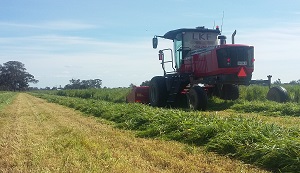 |
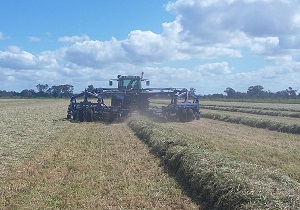 |
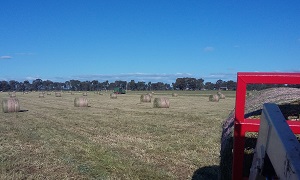 |
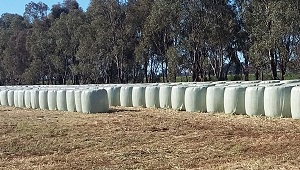 |
28/08/20
Millah Murrah Klooney heifers
Having used three Klooney straws at joining, we were lucky enough to get three heifer calves on the ground which is everything we could have hoped for. We saw some Klooney progeny during Beef Week last year at Witherswood Angus amongst 120 bulls by various sires that were on display. We were just there for a sticky beak but the Klooney calves really stood out and even though I didn't have intentions of using an Angus bull I saw the opportunity to bring in some outcross genetics and improve our herd. Our new Klooney heifers are GR1 but we aim to breed a GR2 bull so we can eventually produce purebred bulls with some genetic diversity. We consulted with our regular clients before going down this track in case they had concerns about our using an Angus bull. They fully supported our breeding decisions - so long as we keep producing the sort of structurally sound bulls they need, with big eye muscles, plenty of shape and softness.
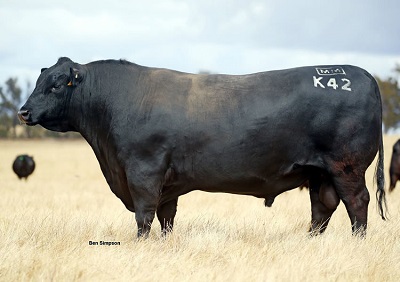
27/07/20
The fun has begun!
We drafted off the AI cows at the weekend to join the earlies in the calving paddock and we are all pacing the house with binoculars in hand looking out for calving cows. Davo is on leave from work ready to tag and weigh and get some jobs done around the farm. There are four calves already - two of which arrived early in a further paddock so he had to weigh the calves old-style with the bathroom scales (thankfully his back stood up to the challenge). Stop the press! Make that five calves - Jasmine J22 just had a Keystone calf! We are using three new sires this year: Millah Murrah Klooney (Angus, AI), The Glen Keystone (AI) and The Glen Intensity. We will also have our first calves from Mount Major Peregrine, a Eylwarra Sands Falcon son. These bulls have been selected to bring in some out-cross genetics and maitain our goals of low birthweight calves with fantastic growth, big EMAs and high IMF.
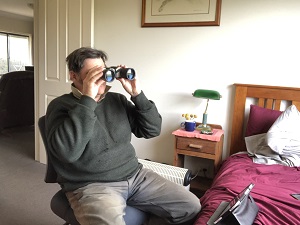 |
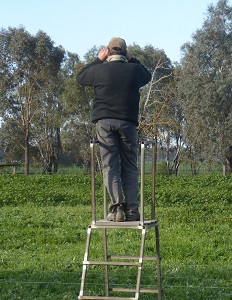 |
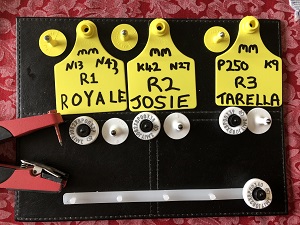 |
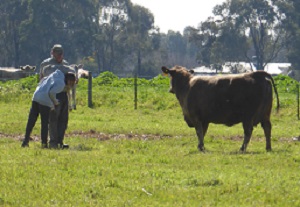 |
12/07/2020
Introducing Nell
On our way back from our road trip we picked up my new puppy from Finley - and we were very lucky we did, because a few days later the VIC/NSW border was shut for the first time in 100 years. She is a very clever little puppy and I chose her because of her no-fuss temperament. Nothing seems to faze her. Her breeder was recommended to me by another farmer who has a full sibling and says it is the best dog he has ever had. Sadly, we had to get Roger put down earlier this year and whilst Poppy, Maisie's dog, is excellent, I wanted another working dog and Nell will be all mine! I'm enjoying having another puppy and looking forwards to having another working dog around the property.
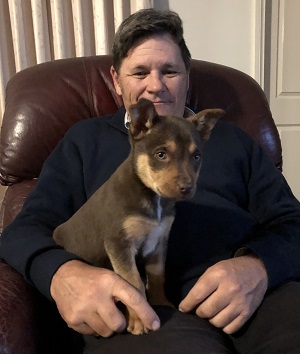
Holbrook
It was great to catch up with Geoff, Gaye & Tim Roberts. Geoff has been a major client since 2016: he buys four bulls a year which go in with 100 heifers and those four bulls are mated to the same mob of cows for the next 5 years. I always enjoy talking about farming and farming systems with Geoff and I was very excited to see how our bulls have fully matured. The research says that selling yearling bulls, as we do, is better than selling them as older bulls because they tend to last longer in the herd but for me this means I don't get to see them fully mature until I visit clients. And it was very special to see so many all in one place of different ages. Even though we do get every animal structrally assessed, I was rapt to see how well the feet on these bulls have stood up to the work. I was really pleased that out of the 16 bulls Geoff has purchased over the years, only one has left his herd, and that was due to injury: all the others are still working. Liquorice (pictured below) is Geoff & Tim's favourite bull. He has an EMA of +5.1 and is chock full of meat, as you can see. I'd say he is about a frame score 6. He is long and deep and full of meat!
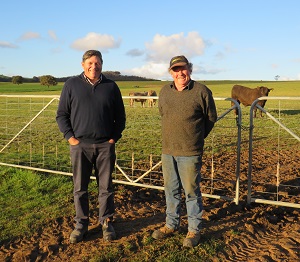 |
Mount Major Liquorice DVD L7 |
Tumbarumba
In the first week of the school holidays, with restrictions still lifted, we went on a little road trip to catch up with some bull clients. Our first stop was Tumbarumba where James Bremner and his family farm. James has bought a few bulls from us over the years and has invited me to come up and look at his herd a few times, so it was good to be able to take up the offer. After a lovely lunch (thanks, Gemma!) James gave us a thorough tour of his farm and we got to see a couple of our young bulls and hear about his plans and improvements for the farm. The recent bushfires have been major setback for him but his hard work and enthusiasm for his farm are inspiring.
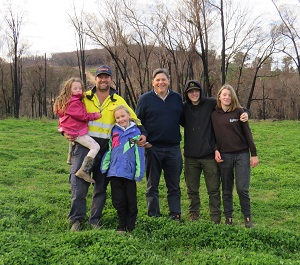
Visit from Charles and Janet Wallace
It's always lovely to have friends come and look at your herd and be able to talk cows but I hold Charles's opinion on cattle in very high regard and it was great to get his feedback and comments on my herd. Charles was really impressed with Rogialyn Jupiter and his progeny. Coronovairus restrictions had recently been lifted so this visit was even more special. Even so, Charles and Janet were facing two weeks of self-isolation when they returned to Tasmania. Pictured here is Katrina M3, first up for a pat and enjoying a scatch with the wiggle dance.
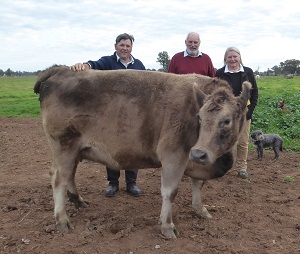
15/06/2020
Biolinks
In 2013 we worked with two neighbours to link up two remnant stands of trees, including a seasonal creek. The CMA were advertising for suitable projects so we talked to our neighbours and put together a plan to set up a stretch of fenceline revegatation. In all, a bit of 10 km of new fencing was erected, nearly 2 miles North-South and another mile and a half East-West. There was a mix of planting of seedlings and some direct seeding (as a bit of a trial) and it has worked out superbly. There is now a lovely dense stand which is filling up rapidly with birdlife. The treeline runs along out western boundary, with our Northside paddocks on the right hand side of these photos, and so the trees are starting to provide shelter to the cows from south-westerly winds. The big tree you can see on the right of the first picture is the same as the biggest tree you can see in the second picture.
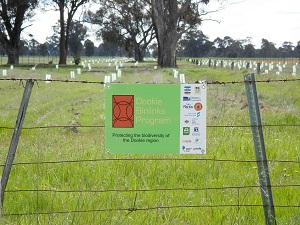 |
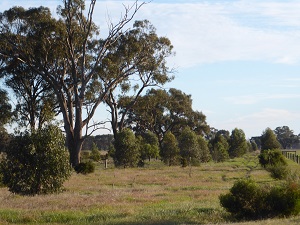 |
20/05/2020
Rock on!
This time of year we turn our thoughts to maintenance work on tracks, troughs and gateways. Weather predictions are all pointing towards a potentially wetter winter and spring. I remember wet winters when cows were standing up to their bellies in mud for weeks, when it was hard to find an area to feed them that wouldn't waste tonnes of feed, and it was pretty much too wet for them or for tractors to be on the paddocks. I don't want to go through that again - or at least I want to be able to manage it as well as possible. So, I have laid down some rock to make an area right next to the hayshed that will give me somewhere to put feed that will allow the cows to be standing out of the mud.
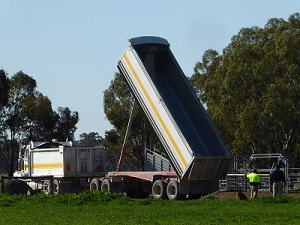 |
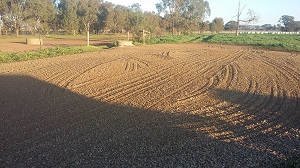 |
27/04/2020
We spent a damp Sunday morning planting trees to try and set up some shade for our two paddocks that need it. We have boxed off some sections of the fence line and have had a couple of attempts at getting trees going in here in the past but the dry seasons have been against us. This time we have sprayed out the weeds, used tree guards and mulched - we just need to remember to give these lttle trees some attention in summer but at least with the tree guards they will be easier to check on: in the past the little trees have been lost amongst the lucerne plants which were no doubt also competing for moisture. We have chosen Grey Box for the paddock with the heaavier dirt and Yellow Box for the other, both locally sourced. Yellow Box is Davo's favourite.
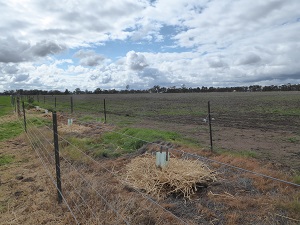 |
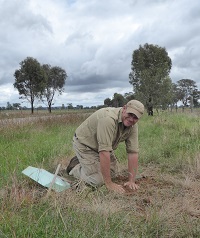 |
20/01/2020
Well, we are 4 weeks into "Work from Home" and social distancing and somehow we haven't found time to update the news page. So what have we been up to, you might ask?
Bagging oats and gettng fertiliser ordered ready for sowing tomorrow. We've had some really good rainfall and have got some good soil moisture.
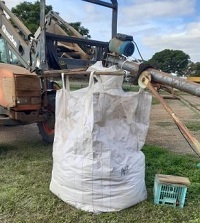 |
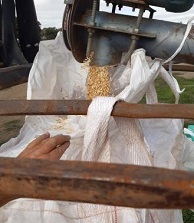 |
Rains in late March were enough to strike some pasture, the lucerne responded in spades as the conditions were still warm. Follow up rain in April has feed jumping out of the ground (at last!). Normally at this time of year our paddocks are dry - the break is normally around ANZAC day so we are about 10 weeks ahead of the feed curve. With some early green feed and the continuing warm conditions, we should be set up for winter quite nicely.
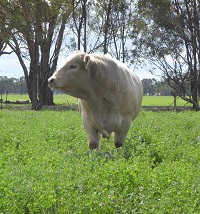 |
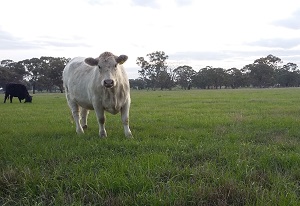 |
Repainting the grille on Sarah's old red tractor (an International 434) which is getting a bit of a spruce up: it's had a new ignition and solenoid on the starter motor. We mainly use it for slashing but it runs like a clock and is very handy to have around. I'm going to paint a little bit at a time - I'm not finished yet, but it's starting to look a bit flash.
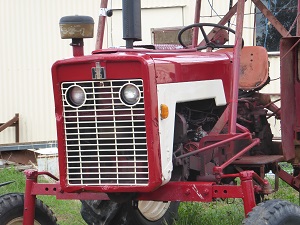
With no football at the weekends there is a bit more time at the weekends so we've been getting ready for winter and getting a bit of wood in the shed. This year the old bloke on the chainsaw couldn't keep up with the young bloke on the log splitter. It must be nearly time to swap!
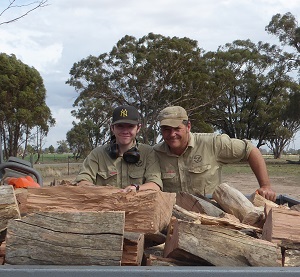
8/02/2020
Mount Major Pongo was delivered to repeat clients, Andrew and Katrina Holland, today. He is happy to be out strutting his stuff with the ladies.
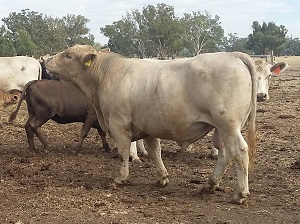
Drought feeding
The cattle are tracking well through the long hot summer. Even though it's a tough season, the colours of the sunsets are beautiful.
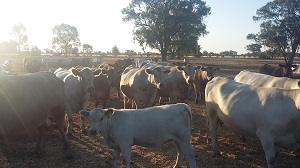
4/01/2020
Welcome to a New Decade - 2020!
Christmas holidays are a good time to get on top of some jobs. Davo has been teaching Maisie how to drive the tractor and has re-painted our cattle trailer. His dad bought the trailer in 1982. We keep it mechanically in A1 condition and it has been repainted probably every decade but it's starting to show its age. With it being low and wide, it is so good for delivering bulls. If there is no ramp, we can step animals out of the trailer and into the paddock which is just so handy.
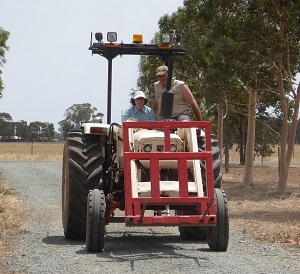 |
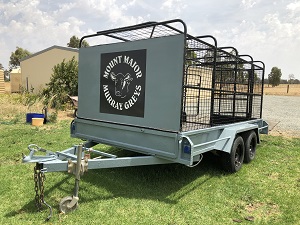 |


